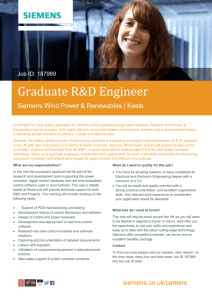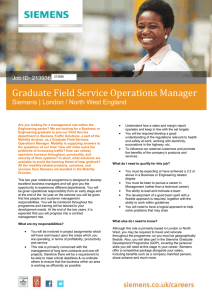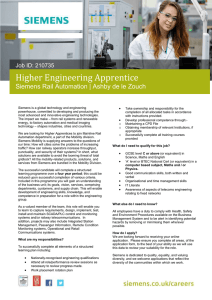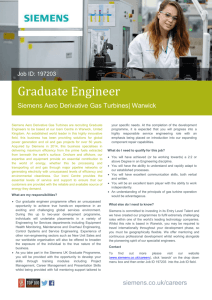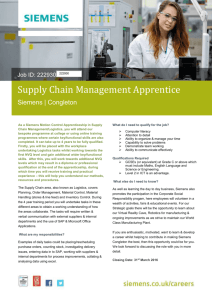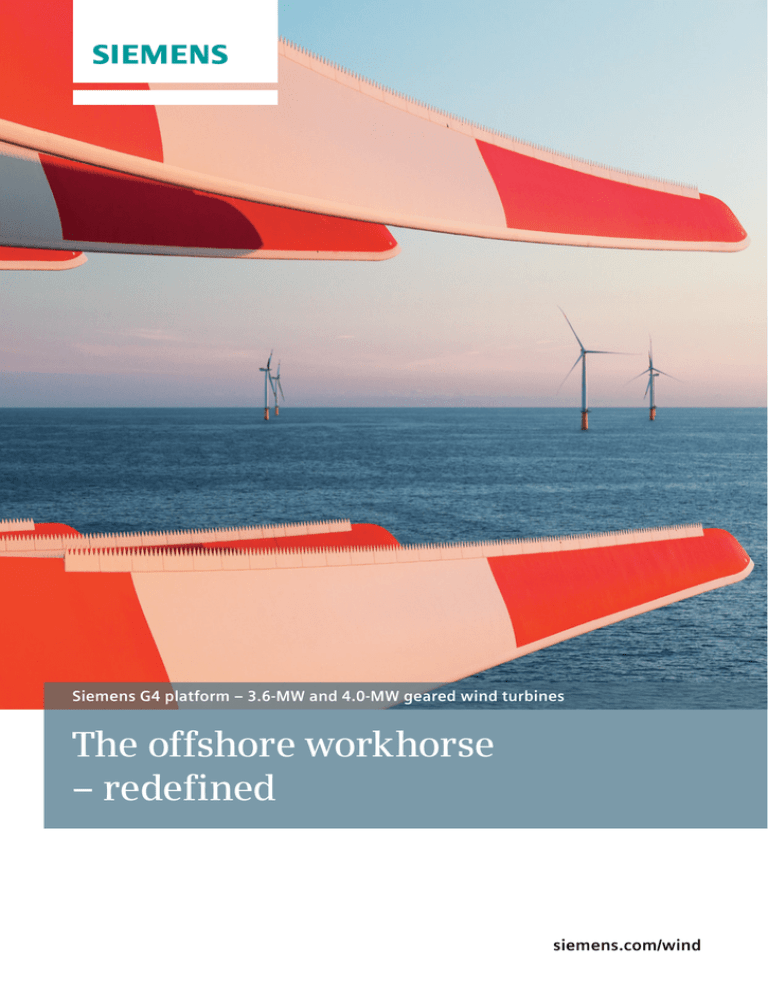
Siemens G4 platform – 3.6-MW and 4.0-MW geared wind turbines
The offshore workhorse
– redefined
siemens.com/wind
SWT-3.6-120
SWT-4.0-120
Siemens, the offshore leader
Intelligent ways to drive down
the cost of electricity
Siemens has been a major driver of innovation in the wind
power industry since 1980, when wind turbine technology
was still in its infancy.
Wind power is coming of age. It is fast becoming directly
competitive with traditional energy sources. Driving
down the levelized cost of wind energy is a key target for
Siemens as we strive to make wind power independent of
subsidies.
Technology has changed with the times, but Siemens’
commitment to providing its customers with proven wind
turbine solutions remains the same.
In recent times, the world has seen an intense increase in
the nature and capacity of offshore wind power plants.
Given the logistical challenges of offshore projects, where
even the smallest issue can amplify costs, having technology
that works and continues to work is paramount. That is
exactly the right task for Siemens.
Drawing on more than 30 years of experience in the
wind power industry, a strong focus on renewables, and
a global network of highly skilled and trained employees,
Siemens has proven itself to be a trustworthy and reliable
business partner and will continue to do so in the future.
2
In 1991 we installed the world’s first offshore wind farm
at Vindeby in Denmark. From these modest beginnings
to today, Siemens benefits from a track record that
makes it the world leader in offshore applications. As the
choice for the world’s largest offshore wind power plant –
the London Array – Siemens’ geared wind turbines are
paving the way for green energy to become the cornerstone of the global energy mix.
Over the years, Siemens has accumulated a vast amount
of service experience offshore. Drawing on this substantial
knowledge, the company has established a flexible range
of service solutions that are designed to optimize the
output of offshore wind turbines.
Our new platform strategy is founded on the knowledge
and experience of more than 30 years in wind power.
Standardization and modularization are fundamental to
the platform approach, allowing us to streamline manufacturing installation and develop a lean design process.
Each of our products is now a member of one of four
platforms: the Siemens G2, Siemens D3, Siemens G4,
and Siemens D7. “G” denotes geared turbines, “D”
signifies direct drive technology, and the associated
numbers represent the predominant power rating.
SWT-4.0-130
Evolution of the platform
Determined to create the right machine for the right
application, Siemens has progressively adapted the G4
platform to provide customers with a greater choice of
technologies to meet their needs. The SWT-3.6-120 was
an incremental advance on the proven technology of
the SWT-3.6-107, which had become the most popular
offshore wind turbine in the history of Siemens Wind
Power.
With the release of a 4.0-MW wind turbine – featuring a
130-meter rotor and a more powerful generator – Siemens
has improved on a proven technology, allowing for
increased power output and revenue while keeping
investment risk low.
The G4 platform comprises offshore geared wind turbines
with a power rating of 3.6 MW and 4.0 MW.
3
The new SWT-4.0-130
The next step in reliable offshore energy
Enhanced design efficiency
Aeroelastic blades for greater lifetime output
Optimized and robust design
While the 4.0-MW turbine is based directly on the 3.6-MW
turbine, it features improvements based on years of
operational experience. Its structure has been strengthened,
making it even more robust. The optimized nacelle
design also features an improved layout, optimizing the
ergonomics during installation and maintenance.
A simplified tower design with fewer weld points has led
to both lower weight and greater strength. Both the
gearbox and generator have been updated to increase
efficiency and resilience.
Thoroughly proven on onshore wind turbines, the benefits
of Siemens’ aeroelastic technology have been extended
to the offshore environment. The B63 blade used on the
SWT-4.0-130 also features this blade technology.
Megawatt for megawatt, its simplified yet robust design
makes it lighter than its predecessors. More importantly,
the new larger rotor coupled with a more powerful generator increases net annual energy production by up to
15 percent at IEC I conditions. These improvements allow
Siemens to drive down the cost of offshore wind energy.
The 4.0-MW is equipped with 63-meter-long rotor
blades, giving it a swept area of 13,300 m2, which is
equal to approximately two football fields – and
18 percent larger than that of its predecessor. Combined
with the added efficiency of the new geared drivetrain,
the result is up to 15 percent more power output at IEC I
conditions.
The upgrade to 4.0 MW has been achieved through
minimum incremental upgrades, expanding on the same
fundamental G4 platform design. By utilizing proven
components and technologies to the greatest extent
possible, Siemens has eliminated many of the variables
traditionally associated with the introduction of a new
product. The incremental upgrade approach also allows
for a very short time-to-market.
A 130-meter rotor for a higher AEP
A larger rotor traditionally increases the loads on a wind
turbine, which calls for larger and heavier structural
components. Siemens’ aeroelastically tailored blade
changes all that. The secret of this technology is found in
the intelligently controlled torsional twisting of the blade
when the rotor faces aerodynamic loading.
The result is optimized load characteristics at all wind
speeds. In addition, the B63 blade benefits from Siemens’
Quantum Blade Technology, meaning that the new larger
rotor is barely heavier than its smaller predecessor while
retaining excellent strength – as proven by
extensive testing.
The new larger 130 meter rotor is
barely heavier than its predecessor
while still retaining excellent
strength
4
5
Proven technology,
advanced performance
Swept area:
11,300 m2
Siemens NetConverter®
Power boost functionality
The NetConverter® system offers maximum flexibility in
the turbine’s response to voltage and frequency control,
fault ride-through, and output adjustment. As a result,
Siemens wind turbines can be configured to comply with
a variety of relevant grid codes in major markets and can
be readily connected to the grid.
The Siemens Wind Power power boost functionality is a
wind turbine control feature that increases the annual
energy production of the turbine by raising the rating up
to 5 % depending on site conditions. The feature is implemented, operated, and controlled on each wind turbine.
Swept area:
11,300 m2
Rotor diameter: 120 m
Swept area:
13,300 m2
Rotor diameter: 120 m
Rotor diameter: 130 m
Vibration diagnostics service
Siemens IntegralBlade® technology
The rotors of the G4 platform benefit from blades
manufactured using patented IntegralBlade® technology.
The blades are made in one piece from fiberglassreinforced epoxy resin in a single production step.
As a result, all glue joints – the potential weak points
that could expose the structure to cracking, water
ingress, ice formation, and lightning damage – are
eliminated.
Siemens WebWPS SCADA system
Via a standard Web browser, the Siemens WebWPS SCADA
system provides a variety of status views of electrical,
mechanical, meteorological, and grid station data as well
as operation and fault status.
High Wind Ride Through functionality
Wind turbines are normally programmed to shut down
if the 10-minute mean wind speed exceeds 25 m/s.
This may lead to significant challenges for the grid system
if the turbines in large wind farms are shut down more
or less simultaneously, for example, at the passage of a
gust front.
The Siemens G4 platform supports grid stability with
the High Wind Ride Through system. It replaces the fixed
high wind shutdown threshold with an intelligent loadbased reduction in output power at certain storm-level
wind speeds.
Our vibration diagnostics service enables us to detect
anomalies early on and prevent potential failures. This
requires our diagnostics experts to analyze vibration patterns and compare them with values from the Siemens
database. This database is founded on archived records
from almost 10,000 Siemens wind turbines. Thanks to
these analyses combined with predictive methods, we
can optimize service planning and repair components
proactively before serious damage can occur. Since July
2008, we have been able to detect 97 percent of all
potential gear-tooth cracks and prevent them from
becoming fatal.
SWT-3.6-120
SWT-4.0-120
SWT-4.0-130
IEC Class
IA
IEC Class
IA
IEC Class
IB
Rotor diameter
120 m
Rotor diameter
120 m
Rotor diameter
130 m
Blade length
58.5 m
Blade length
58.5 m
Blade length
63.45 m
Swept area
11,300 m
Swept area
11,300 m
Swept area
13,300 m2
Hub height
Site specific
Hub height
Site specific
Hub height
Site specific
Power regulation
Pitch regulated
Power regulation
Pitch regulated
Power regulation
Pitch regulated
2
2
Service
With an increasing number of turbines being installed
around the globe, consistency is essential for generating
an optimal return on investment throughout a project’s
lifetime. Whether you operate wind turbines at inland,
coastal, or offshore sites, our service team will craft an
intelligent Siemens service solution that is custom-made
for your needs. They will collaborate with you to deliver
reliability and maximum output under all conditions.
Ongoing improvements in safety
Safety is at the heart of all Siemens operations. From
production to installation, operation, and service, Siemens
strives to set the standard for a zero-harm culture. With
the SWT-4.0-130, offshore maintenance has been
rethought. Service technicians can enter the turbine via
the heli-hoist platform or a conventional tower access,
where a new gangway system enables safer access in
rough sea conditions. The new, more spacious nacelle
also provides technicians with optimized access to all key
components.
Setting the scene for modern
offshore wind power
Ongoing evolution of offshore
wind power
The biggest and most advanced
rotor in its class
The design of this wind turbine is
based on our long-term experience
in offshore wind power. With a
swept area 26 percent larger than
its predecessor, it makes a giant
leap forward with respect to energy
yield. Compared with the
SWT-4.0-120, the SWT-3.6-120 is a
competitive choice for sites with
capacity constraints.
Based on millions of operating hours
and experience accumulated from
the 3.6-MW class, the capacity
upgrade to 4.0 MW is founded on
confidence. The SWT-4.0-120 features
the proven 120-meter rotor that has
been used in offshore applications
since 2009. This makes the installation
of a 4.0-MW turbine suitable for
environments where maximum
tip-height restrictions apply.
By using advanced blade technologies,
Siemens increased the 4.0-MW rotor
diameter by another ten meters –
and the swept area by an astounding
18 percent. This allows for a significant
increase in energy production, and
thanks to the aeroelastically tailored
blade technology, this is possible
without compromising the structural
load.
The proven technology of the 3.6-MW, combined with the upgraded 4.0-MW, means the G4 platform is the perfect
choice for a reliable and profitable investment.
6
7
Published by and copyright © 2015:
Siemens AG
Wind Power and Renewables Division
Beim Strohhause 17-31
20097 Hamburg, Germany
siemens.com/wind
For more information, please contact
our Customer Support Center.
Phone: +49 180 524 70 00
Fax: +49 180 524 24 71
(Charges depending on provider)
E-mail: support.energy@siemens.com
Wind Power
Order No. WPOF-B10006-00-7600
RS 15_01_203
All rights reserved.
Subject to change without prior notice.
Trademarks mentioned in this document are the property
of Siemens AG, its affiliates, or their respective owners.
The information in this document contains general
descriptions of the technical options available, which
may not apply in all cases. The required technical options
should therefore be specified in the contract.

